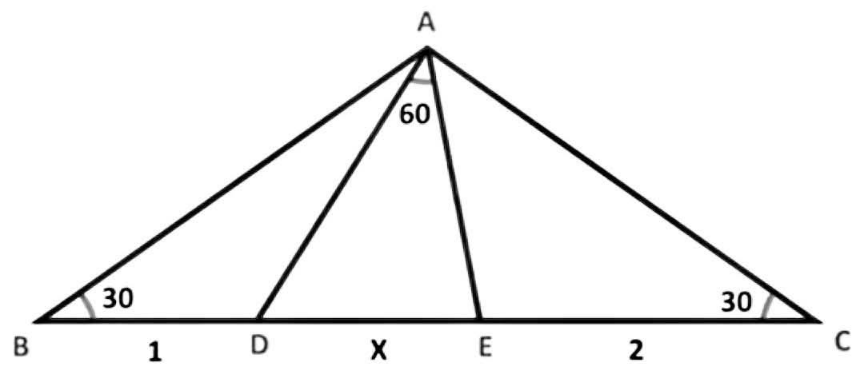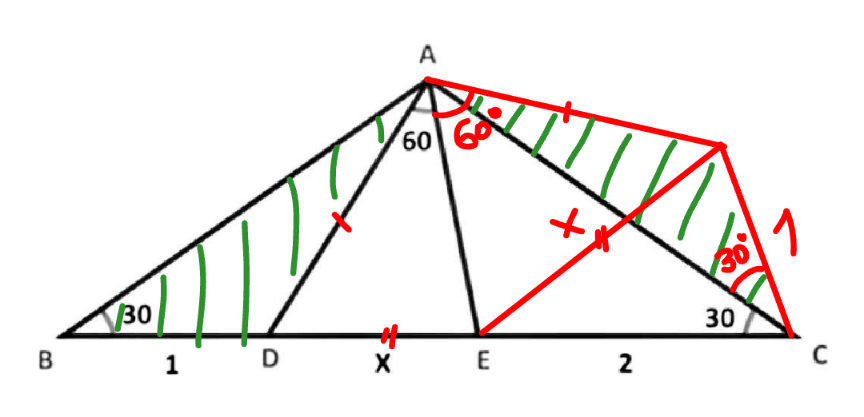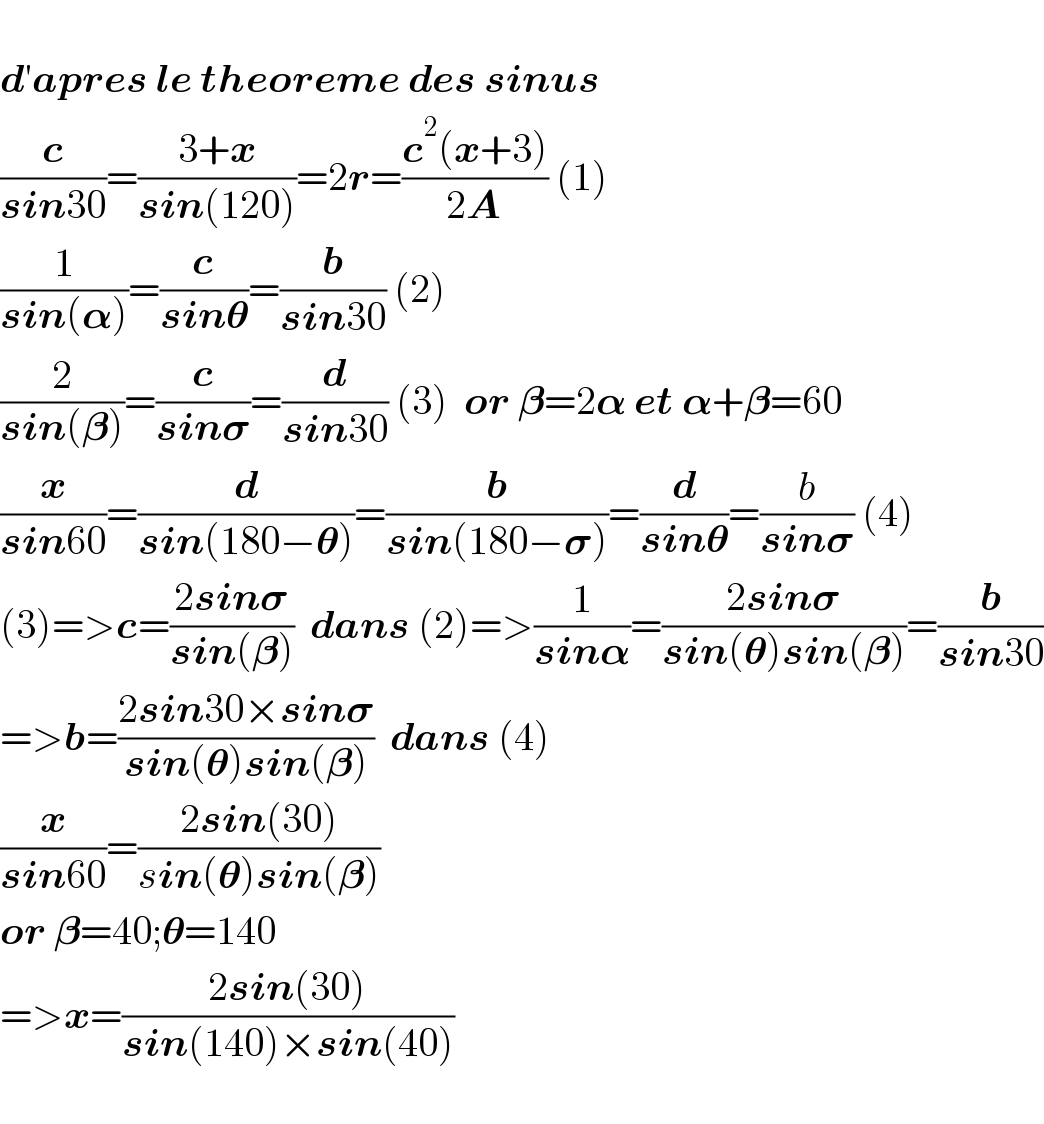
Question Number 217199 by cherokeesay last updated on 05/Mar/25

Commented by cherokeesay last updated on 05/Mar/25

$$\mathrm{find}\:\mathrm{the}\:\mathrm{value}\:\mathrm{of}\:\mathrm{x} \\ $$
Answered by mr W last updated on 06/Mar/25

$${x}=\sqrt{\mathrm{1}^{\mathrm{2}} +\mathrm{2}^{\mathrm{2}} −\mathrm{1}×\mathrm{2}}=\sqrt{\mathrm{3}} \\ $$$${generally}\:{x}=\sqrt{{a}^{\mathrm{2}} +{b}^{\mathrm{2}} −{ab}} \\ $$
Commented by mr W last updated on 05/Mar/25

Commented by cherokeesay last updated on 05/Mar/25

$${thank}\:{you}\:{so}\:{much} \\ $$$${master}\:! \\ $$
Answered by profcedricjunior last updated on 05/Mar/25

$$ \\ $$$$\boldsymbol{{d}}'\boldsymbol{{apres}}\:\boldsymbol{{le}}\:\boldsymbol{{theoreme}}\:\boldsymbol{{des}}\:\boldsymbol{{sinus}} \\ $$$$\frac{\boldsymbol{{c}}}{\boldsymbol{{sin}}\mathrm{30}}=\frac{\mathrm{3}+\boldsymbol{{x}}}{\boldsymbol{{sin}}\left(\mathrm{120}\right)}=\mathrm{2}\boldsymbol{{r}}=\frac{\boldsymbol{{c}}^{\mathrm{2}} \left(\boldsymbol{{x}}+\mathrm{3}\right)}{\mathrm{2}\boldsymbol{{A}}}\:\left(\mathrm{1}\right) \\ $$$$\frac{\mathrm{1}}{\boldsymbol{{sin}}\left(\boldsymbol{\alpha}\right)}=\frac{\boldsymbol{{c}}}{\boldsymbol{{sin}\theta}}=\frac{\boldsymbol{{b}}}{\boldsymbol{{sin}}\mathrm{30}}\:\left(\mathrm{2}\right) \\ $$$$\frac{\mathrm{2}}{\boldsymbol{{sin}}\left(\boldsymbol{\beta}\right)}=\frac{\boldsymbol{{c}}}{\boldsymbol{{sin}\sigma}}=\frac{\boldsymbol{{d}}}{\boldsymbol{{sin}}\mathrm{30}}\:\left(\mathrm{3}\right)\:\:\boldsymbol{{or}}\:\boldsymbol{\beta}=\mathrm{2}\boldsymbol{\alpha}\:\boldsymbol{{et}}\:\boldsymbol{\alpha}+\boldsymbol{\beta}=\mathrm{60} \\ $$$$\frac{\boldsymbol{{x}}}{\boldsymbol{{sin}}\mathrm{60}}=\frac{\boldsymbol{{d}}}{\boldsymbol{{sin}}\left(\mathrm{180}−\boldsymbol{\theta}\right)}=\frac{\boldsymbol{{b}}}{\boldsymbol{{sin}}\left(\mathrm{180}−\boldsymbol{\sigma}\right)}=\frac{\boldsymbol{{d}}}{\boldsymbol{{sin}\theta}}=\frac{{b}}{\boldsymbol{{sin}\sigma}}\:\left(\mathrm{4}\right) \\ $$$$\left(\mathrm{3}\right)=>\boldsymbol{{c}}=\frac{\mathrm{2}\boldsymbol{{sin}\sigma}}{\boldsymbol{{sin}}\left(\boldsymbol{\beta}\right)}\:\:\boldsymbol{{dans}}\:\left(\mathrm{2}\right)=>\frac{\mathrm{1}}{\boldsymbol{{sin}\alpha}}=\frac{\mathrm{2}\boldsymbol{{sin}\sigma}}{\boldsymbol{{sin}}\left(\boldsymbol{\theta}\right)\boldsymbol{{sin}}\left(\boldsymbol{\beta}\right)}=\frac{\boldsymbol{{b}}}{\boldsymbol{{sin}}\mathrm{30}} \\ $$$$=>\boldsymbol{{b}}=\frac{\mathrm{2}\boldsymbol{{sin}}\mathrm{30}×\boldsymbol{{sin}\sigma}}{\boldsymbol{{sin}}\left(\boldsymbol{\theta}\right)\boldsymbol{{sin}}\left(\boldsymbol{\beta}\right)}\:\:\boldsymbol{{dans}}\:\left(\mathrm{4}\right) \\ $$$$\frac{\boldsymbol{{x}}}{\boldsymbol{{sin}}\mathrm{60}}=\frac{\mathrm{2}\boldsymbol{{sin}}\left(\mathrm{30}\right)}{{s}\boldsymbol{{in}}\left(\boldsymbol{\theta}\right)\boldsymbol{{sin}}\left(\boldsymbol{\beta}\right)} \\ $$$$\boldsymbol{{or}}\:\boldsymbol{\beta}=\mathrm{40};\boldsymbol{\theta}=\mathrm{140} \\ $$$$=>\boldsymbol{{x}}=\frac{\mathrm{2}\boldsymbol{{sin}}\left(\mathrm{30}\right)}{\boldsymbol{{sin}}\left(\mathrm{140}\right)×\boldsymbol{{sin}}\left(\mathrm{40}\right)} \\ $$$$ \\ $$
